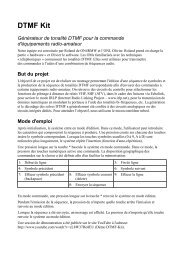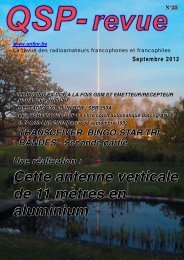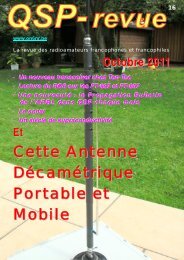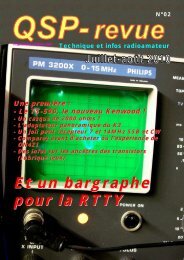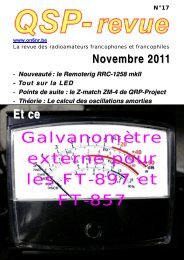toutes bandes et Un adaptateur long-fil tout simple pour votre récepteur
Février 2013
Février 2013
- No tags were found...
Create successful ePaper yourself
Turn your PDF publications into a flip-book with our unique Google optimized e-Paper software.
Le site web de l’UIT est instructif. Vous y trouverez<br />
beaucoup de choses intéressantes à savoir :<br />
http://www.itu.int/fr/Pages/default.aspx<br />
L’acronyme de février<br />
UTC : On l’appelait "Greenwich" dans le temps.<br />
Maintenant, c’est UTC. C’est le césium qui lui donne <strong>tout</strong>e<br />
sa précision.<br />
VCO Il y en a au moins un dans quasiment tous les<br />
transceivers modernes. Et vous en avez probablement<br />
déjà construit sans le savoir.<br />
Mais que signifient-ils ? Réponse à l’adresse de la revue<br />
Les bull<strong>et</strong>ins DX <strong>et</strong> contests<br />
ARLP08 Propagation Bull<strong>et</strong>in<br />
ZCZC AP08<br />
QST de W1AW<br />
Propagation Forecast Bull<strong>et</strong>in 8 ARLP008<br />
From Tad Cook, K7RA<br />
Seattle, WA February 22, 2013<br />
To all radio amateurs<br />
Average daily sunspot numbers over the past seven days,<br />
February 14-20, rose modestly by 27 points to 78.3.<br />
Average daily solar flux was up marginally, only 1.6<br />
points to 105.6. Geomagn<strong>et</strong>ic indices rose also, with the<br />
plan<strong>et</strong>ary A index from 5.6 to 6.4, and the middle latitude<br />
A index from 5.1 to 6. This is compared to the previous<br />
seven days, February 7-13 reported in last week's<br />
bull<strong>et</strong>in.<br />
There was a more substantial rise in both solar flux and<br />
sunspot numbers for a recent three days, at 104.7, 112.4<br />
and 113.5 for solar flux, and 92, 117 and 106 for sunspot<br />
numbers. But that turned around when the sunspot<br />
number dropped from 106 to 75 on Thursday, February<br />
21 and solar flux declined from 113.5 to 108.5.<br />
The predicted solar flux is 105 on February 22-23, 100 on<br />
February 24, 95 on February 25-26, 100, 105 and 110 on<br />
February 27 through March 1, 100 on March 2-3, 95 on<br />
March 4-14, 100 on March 15-16, 115 on March 17, and<br />
120 on March 18-20, which represents a peak for the next<br />
45 days.<br />
The predicted plan<strong>et</strong>ary A index is 8 on February 22, 10<br />
on February 23, 8 on February 24, 5 on February 25-28,<br />
10 and 8 on March 1-2, 5 on March 3-10, 7 on March 11-<br />
12, and 5 on March 13-27.<br />
Over the next month we can look forward to improving<br />
HF conditions as we progress toward the Spring Equinox,<br />
which occurs on Wednesday, March 20 at 1102z.<br />
Using a propagation prediction program such as<br />
W6ELprop gives us a rough idea of what the seasonal<br />
improvement might be. Running two instances of the<br />
program simultaneously, once for February 21 and the<br />
other on March 21, but with the same solar flux (I used<br />
107) allows me to flip back and forth b<strong>et</strong>ween the results.<br />
I did one for Seattle to Japan, and the 15 m<strong>et</strong>er opening<br />
from 2200z to 0030z on February 21 shows up as a 2130-<br />
0500z opening on March 21. Similarly, a 17 m<strong>et</strong>er<br />
opening from 2130-0230z on February 21 str<strong>et</strong>ches to<br />
2030-0500z on March 21.<br />
OK1HH predicts the geomagn<strong>et</strong>ic field as qui<strong>et</strong> to active<br />
on February 22, active to disturbed on February 23,<br />
mostly qui<strong>et</strong> February 24-25, qui<strong>et</strong> on February 26-28,<br />
qui<strong>et</strong> to uns<strong>et</strong>tled March 1, qui<strong>et</strong> to active March 2,<br />
mostly qui<strong>et</strong> March 3, qui<strong>et</strong> to uns<strong>et</strong>tled March 4, qui<strong>et</strong><br />
March 5-6, mostly qui<strong>et</strong> March 7-8, qui<strong>et</strong> March 9, and<br />
qui<strong>et</strong> to active March 10.<br />
Several news articles, such as<br />
http://www.upi.com/Science_News/2013/02/20/NASA-<br />
instrument-sees-giant-sunspot-forming/UPI-<br />
80691361403797<br />
and<br />
http://www.science20.com/news_articles/giant_sun_spo<br />
t_size_6_earths_grows_48_hours-104269 mentioned a<br />
huge growing sunspot group 1678 that might spit out<br />
solar flares. But this spot is way over on the western<br />
horizon (yes, the right side is referred to as "west" on the<br />
Sun) and about to slip away from view. It is not geoeffective,<br />
which it would be if it appeared in the center of<br />
the visible solar disc.<br />
Jon Jones, N0JK of Lawrence, Kansas (where I was born!)<br />
has <strong>long</strong> enjoyed working 6 m<strong>et</strong>er E-skip and even DX<br />
using very modest and even compromised antennas. Jon<br />
reported on February 16: "Julian, XE2JS DL68 had a nice 6<br />
m<strong>et</strong>er Es opening to the Midwest Saturday evening<br />
(February 17 UTC). I worked Julian while I was mobile on<br />
highway 40 west of Lawrence, KS EM28 with 58 to 59<br />
signals at 0135 UTC. My 6 m<strong>et</strong>er mobile antenna is a 2<br />
m<strong>et</strong>er 5/8 mag. mount whip (quarter-wave on 6 m<strong>et</strong>ers).<br />
Saw ZL1RS worked TI5/N5BEK earlier at 2254 UTC<br />
February 16."<br />
Yes, Jon feeds that 2 m<strong>et</strong>er whip directly on 6 m<strong>et</strong>ers, no<br />
change in loading or any modification. That distance<br />
b<strong>et</strong>ween him and XE2JS is a little less than 1,000 miles.<br />
QSP N°29 Février 2013 51



